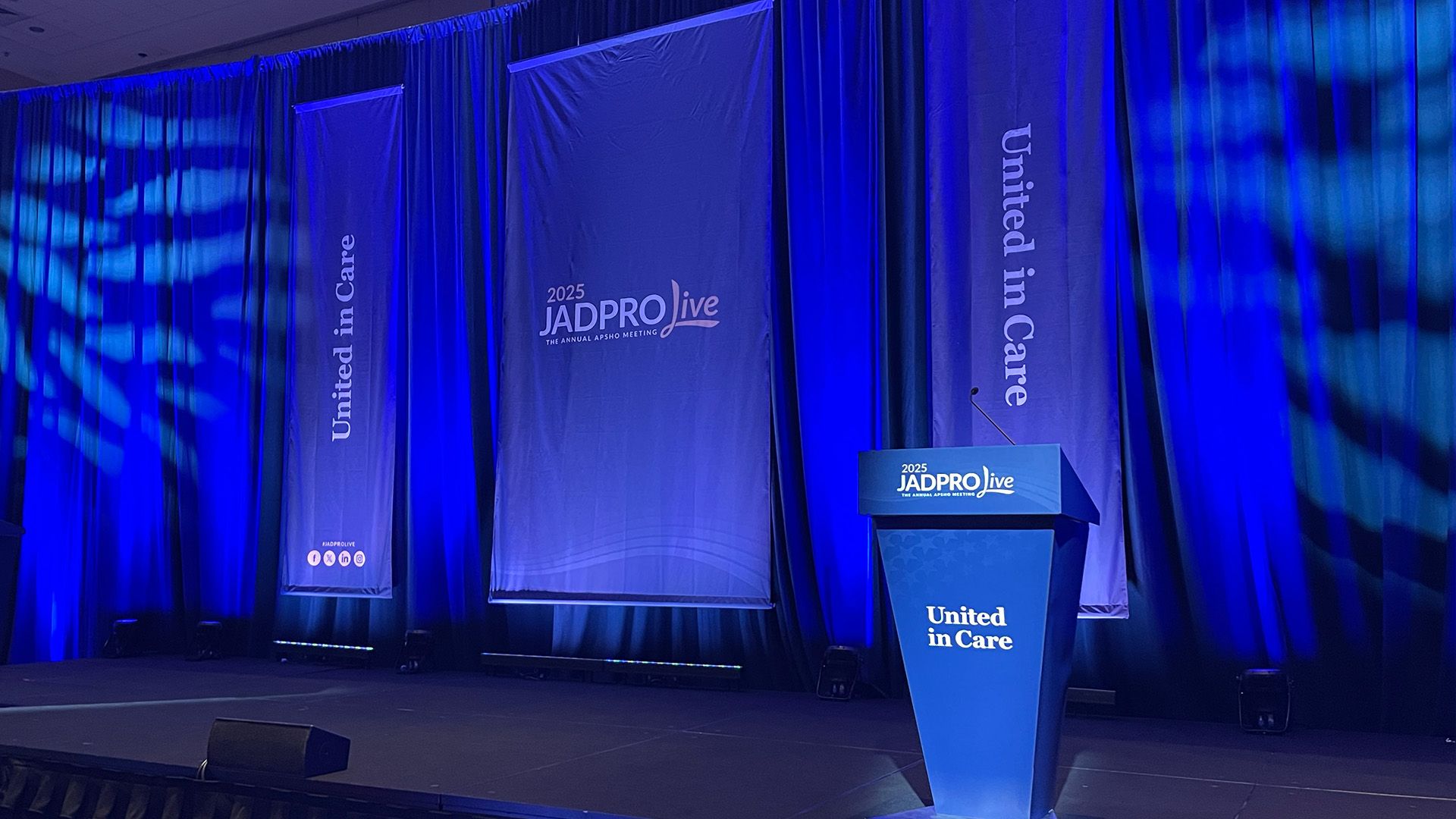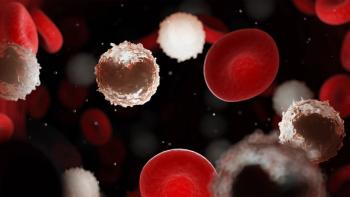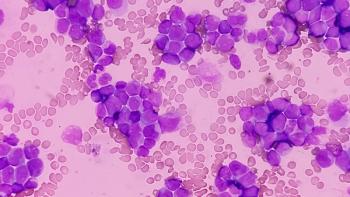
Finley-Oliver Weighs in on Caring for Heavily Pretreated Patients With High-Risk Multiple Myeloma

Beth Finley-Oliver, MSN, ARNP, AGNP-BC, discusses the growing number of new therapies for patients with relapsed or refractory multiple myeloma.
During her presentation at the 2023 JADPRO Live Annual Meeting, Beth Finley-Oliver, MSN, ARNP, AGNP-BC, shared the case of a patient with relapsed/refractory disease who was originally diagnosed with multiple myeloma in 2017 when she was 54 years old. The workup showed that the percentage of plasma cells in this patient’s bone marrow was 35%, and fluorescent in situ hybridization (FISH) testing showed a deletion 17p chromosome deletion.
She was diagnosed with an International Staging System (ISS) score of 1, and her revised ISS score was stage 2 because her Beta2-microglobulin levels were 3.4 mg/L and her albumin levels were 4 g/dL.
This patient started treatment through a clinical trial and received carfilzomib (Kyprolis), lenalidomide (Revlimid), and dexamethasone, achieving a very good partial response with her 9 cycles—which were followed by autologous transplant. She then underwent panobinostat (Farydak) maintenance for 1 year through another clinical trial, which was then followed by maintenance with lenalidomide, until her disease showed biochemical progression.
Multiple lines of therapy ensued. The team tried ixazomib (Ninlaro) plus lenalidomide, but there was no response to this approach. They tried daratumumab (Darzalex), pomalidomide, and dexamethasone, which gave her stable disease, but that response did not last the year.
Following progression with bone disease, they proceeded to another clinical trial, in which the patient underwent carfilzomib and dexamethasone. She achieved a partial response with this therapy, but within another year, her disease progressed, and the team tried CAR T with ciltacabtagene autoleucel (Carvykti). Again, there was a partial response, followed by progression.
The team then tried teclistamab (Tecvayli), which is a bispecific antibody therapy that was approved in late 2022. The patient achieved a partial response with this therapy. However, eventually this was followed by relapse.
Finley-Oliver has been caring for patients with multiple myeloma for about 15 years and currently works in the outpatient hematology clinic at Moffitt Cancer Center. In an interview with Oncology Nursing News following the meeting, she revisited this case study and discussed the implication of the growing number of therapies for patients with relapsed or refractory multiple myeloma.
Approaching Heavily Pretreated Patients
According to Finley-Oliver, one of the first questions to consider as a provider when meeting with a patient who is high risk and who has already undergone many lines of therapy is whether the patient is facing an aggressive relapse—in which case, a quick response is necessary. Whenever possible, she will refer patients to a clinical trial.
If a clinical trial is not an option, then the provider will need to review their history and consider what their disease has not been exposed to yet.
“What haven't they seen?” Finley-Oliver posed. “What myeloma drug has not been introduced to them yet? That is usually where we will go with as the next line of therapy. I have to try and find something their myeloma hasn't seen, and a lot of times that is combination therapy.”
Bispecific Antibodies Shake Up the Treatment Paradigm
Teclistamab, which was approved in 2022, is one of a number of new bispecific antibody therapies to be approved for patients with relapsed/refractory multiple myeloma. Its approval was followed by the approval of elranatamab (Elrexfio) and talquetamab (Talvey). Of note, all these treatments were granted accelerated approval—their continued approval is contingent on ongoing clinical trial investigations.
“The bispecifics are fairly new to us,” Finley-Oliver said. “We have had 3 that were approved this year for patients. I think it is going to change myeloma therapy in the future.”
She shared that she has seen the management of multiple myeloma change over the course of her career. “I remember back in the day when patients were on their fourth line and got stable disease [but they] didn’t really get responses,” she recalled. “Now, with the bispecifics, we are seeing durable responses, and we are seeing more in-depth responses.”
Although these treatments are new, she shared that oncology providers are optimistic about their use and are hoping to increase accessibility in the coming future.
“The challenges with the bispecifics, at least right now, is that most of them are [administered] in academic settings,” she said. “A lot of patients have to travel [because] the community is just not able to support these patients, but hopefully in the future, we will be able to get the bispecifics to all patients.”
Understanding the Safety Profile With Bispecific Antibodies
“The bispecifics are pretty well tolerated,” Finley-Oliver said, noting that all the approved ones do have a ramp-up dosing schedule. “Right now, we're admitting them in the hospital because of the potential of the cytokine release syndrome [CRS].”
According to Finley-Oliver, the risk of CRS is less severe with the bispecifics than it is with CAR T-cell therapy, especially once the patients finish their ramp-up dosing and are being treated in the outpatient setting. However, there is a risk of infections that nurses should be aware of with these medicines.
“It is the infections that we have to keep an eye on with these patients,” she said. “That's probably the biggest thing with these medications.”
Returning to the Case Study
The patient that Finley-Oliver presented on is now about to begin treatment with the recently approved bispecific antibody talquetamab,
Finley-Oliver concluded by noting that the field of multiple myeloma keeps changing and that it can be difficult to stay abreast of all the new approved therapies. She encourages advanced practitioners who work in the community setting to partner with colleagues at their nearby academic institutions to keep up to date on the new therapies available for their patients.
“For patients with multiple myeloma, in general, the more medications we have, the more this is turning into a chronic illness,” she concluded. “It is important for nurses and nurse practitioners to realize who is in front of you [and what] type of myeloma [they have].”
“If you have that patient, but you don't see a lot of multiple myelomas, seek out the specialists in your area. Let them help guide you,” she urged, “because we have had so many drugs approved. It is hard to keep up with everything.”
“Reach out. There are therapies [available], and our patients are living longer and better. With the bispecifics and CAR [T]s, it'll be very, very exciting in the future—I think they're going to move further up in the line with therapy. They're not as toxic, they are very well handled, and they control the disease.”
Reference
Finley Oliver B, Baz R. Individualizing care for multiple myeloma: navigating treatment options and addressing patient needs. Presented at: 2023 JADPROLive. November 9-12, 2023; Orlando, FL.
Newsletter
Knowledge is power. Don’t miss the most recent breakthroughs in cancer care.
















































































